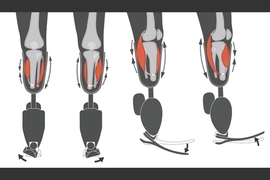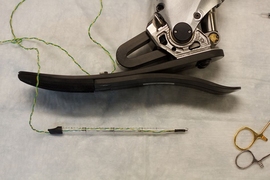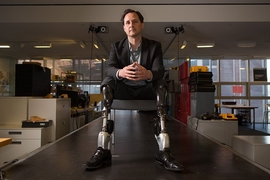For the first time, MIT researchers have shown that nerves made to express proteins that can be activated by light can produce limb movements that can be adjusted in real-time, using cues generated by the motion of the limb itself. The technique leads to movement that is smoother and less fatiguing than similar electrical systems that are sometimes used to stimulate nerves in spinal cord injury patients and others.
While this method was tested on animals, with further research and future trials in humans this optogenetic technique could be used someday to restore movement in patients with paralysis, or to treat unwanted movements such as muscle tremor in Parkinson’s patients, said Shriya Srinivasan, a PhD student in medical engineering and medical physics at the MIT Media Lab and the Harvard-MIT Program in Health Sciences and Technology.
The first applications of the technology might be to restore motion to paralyzed limbs or to power prosthetics, but an optogenetic system has the potential to restore limb sensation, turn off unwanted pain signals or treat spastic or rigid muscle movements in neurological diseases such as amyotrophic lateral sclerosis or ALS, Srinivasan and her colleagues suggest.
The MIT team is one of very few research groups using optogenetics to control nerves outside the brain, Srinivasan said. “Most people are using optogenetics as sort of a tool to learn about neural circuits, but very few are looking at it as a clinically translatable therapeutic tool as we are.”
“Artificial electrical stimulation of muscle often results in fatigue and poor controllability. In this study, we showed a mitigation of these common problems with optogenetic muscle control,” said Hugh Herr, who led the research team and heads the Media Lab’s Biomechatronics group. “This has great promise for the development of solutions for patients suffering from debilitating conditions like muscle paralysis.”
The paper was published in the Dec. 13 issue of Nature Communications. The team included MIT researchers Benjamin E. Maimon, Maurizio Diaz, and Hyungeun Song.
Light versus electricity
Electrical stimulation of nerves is used clinically to treat breathing, bowel, bladder, and sexual dysfunction in spinal cord injury patients, as well as to improve muscle conditioning in people with muscular degenerative diseases. Electrical stimulation can also control paralyzed limbs and prosthetics. In all cases, electrical pulses delivered to nerve fibers called axons trigger movement in muscles activated by the fibers.
This type of electrical stimulation quickly fatigues muscles, can be painful, and is hard to target precisely, however, leading scientists like Srinivasan and Maimon to look for alternative methods of nerve stimulation.
Optogenetic stimulation relies on nerves that have been genetically engineered to express light-sensitive algae proteins called opsins. These proteins control electrical signals such as nerve impulses — essentially, turning them on and off — when they are exposed to certain wavelengths of light.
Using mice and rats engineered to express these opsins in two key nerves of the leg, the researchers were able to control the up and down movement of the rodents’ ankle joint by switching on an LED that was either attached over the skin or implanted within the leg.
This is the first time that a “closed-loop” optogenetic system has been used to power a limb, the researchers said. Closed-loop systems change their stimulation in response to signals from the nerves they are activating, as opposed to “open-loop” systems that don’t respond to feedback from the body.
In the case of the rodents, different cues including the angle of the ankle joint and changes in the length of the muscle fibers were the feedback used to control the ankle’s motion. It’s a system, said Srinivasan, “that in real time observes and minimizes the error between what we want to happen and what’s really happening.”
Stroll versus sprint
Optogenetic stimulation also led to less fatigue during cyclic motion than electrical stimulation, in a way that surprised the research team. In electrical systems, large-diameter axons are activated first, along with their large and oxygen-hungry muscles, before moving on to smaller axons and muscles. Optogenetic stimulation works in the opposite way, stimulating smaller axons before moving on to bigger fibers.
“When you’re walking slowly, you’re only activating those small fibers, but when you run a sprint, you’re activating the big fibers,” explained Srinivasan. “Electrical stimulation activates the big fibers first, so it’s like you’re walking but you’re using all the energy it requires to do a sprint. It’s quickly fatiguing because you’re using way more horsepower than you need.”
The scientists also noticed another curious pattern in the light stimulated system that was unlike electrical systems. “When we kept doing these experiments, especially for extended periods of time, we saw this really interesting behavior,” Srinivasan said. “We’re used to seeing systems perform really well, and then fatigue over time. But here we saw it perform really well, and then it fatigued, but if we kept going for longer the system recovered and started performing well again.”
This unexpected rebound is related to how opsin activity cycles in the nerves, in a way that allows the full system to regenerate, the scientists concluded.
With less fatigue involved, the optogenetic system might be a good future fit for long-term motor operations such as robotic exoskeletons that allow some people with paralysis to walk, or as long-term rehabilitation tools for people with degenerative muscle diseases, Srinivasan suggested.
For the method to make the leap into humans, researchers need to experiment with the best ways to deliver light to nerves deep within the body, as well as find ways to express opsins in human nerves safely and efficiently.
“There are already some 300 trials using gene therapy, and a few trials that use opsins today, so it’s likely in the foreseeable future,” said Srinivasan.
The study was funded by the MIT Media Lab Consortium.









